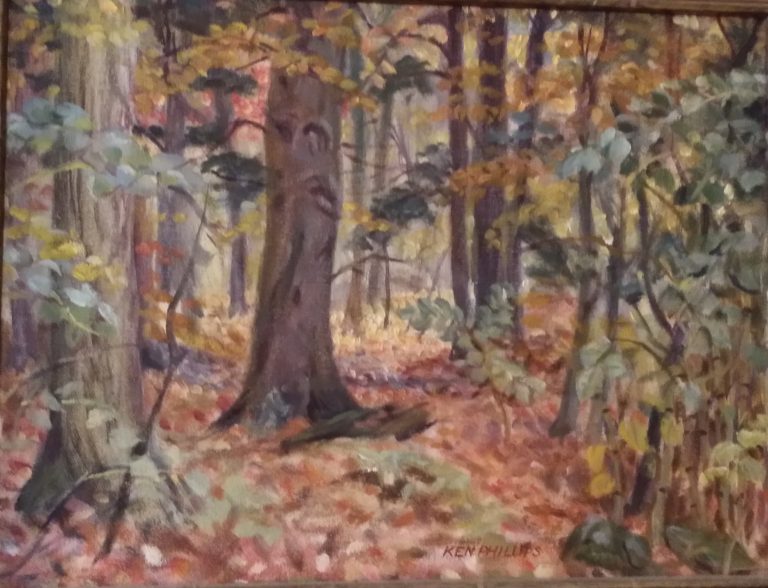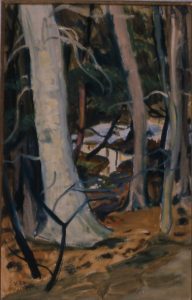My Lost Woods

I have never forgotten nature writer Edwin Way Teale’s remembrance of an Indiana woods he encountered where he was surrounded by “great silent winter trees—oak, beech, hickory, ash and sycamore.” As a small boy he had travelled there with his grandfather. Then, while his grandfather loaded stove wood on their bobsleigh, he had wandered through “gloomy aisles between the trees. Branches rubbed together in the breeze with sudden shrieks or mournful wailings and the cawing of a distant crow echoed dismally.” To the child an air of strangeness and mystery enveloped the dark woods. He remembered that he was both enchanted and fearful.
Thirty years later Teale returned to seek out the ancient trees of that old woodlot which he had visited as a boy, but he never found it. But what he did say was that the powerful experience of the lost woods became a starting point and a symbol for his lifelong absorption in the world of Nature.
Perhaps many of us have a Lost Woods living in our memories, a long gone place which has inspired us ever after.
As for me, I want to tell you about my lost woods. I grew up in a small old growth forest which became a whole world to me. Because my artist parents, Ken Phillips and Marie Cecilia Guard were passionately engrossed in their work, it was the trees surrounding my childhood home which became most truly my people. The great white oaks and pines and beeches loomed over me, gathered me, sang to me. I could tell you my story just in terms of these beloved trees which became engrained in me.
In my earliest memories, from my first bedroom high upstairs, like one in a castle, I pushed open the casement window so the soughing of the pines overhead could keep me company until it was time to get up.
Later, after I was moved to a downstairs bedroom, there was the steadfast white oak which pushed up against my bedroom window. (The story went that because my father had not had the heart to have this big tree cut when our house was being built [picture of Harborn] it grew within touching distance of the tall windows which looked out over that long ago forest.)
This magical bedroom also had its own door stepping out into the clearing in the woods behind our house. I could slip out by myself to swing crazily high from the handmade swing which was stretched between twin pines, swing, it seemed to small Peri, until my feet touched the sky itself.
 But, as my father pointed out, if the surrounding forest was a place of shelter, I must always respect its dangers. I was never allowed to slip down into the shrieking, groaning woods in a gale. And indeed one of my early memories was of a Sunday afternoon after a wind storm when my father swung me up onto his shoulders and carried me deep into the woods to see why in a storm it wasn’t safe. As he strode along, partly he was checking all his community of trees to see if they were well, but also, as he always was, he was teaching me. (He couldn’t help himself.) Look down at the long gnarly roots of the trees, look over your shoulder to see the hawk’s nest high above, touch the sticky chestnut buds, a secret of earliest spring. Suddenly, he came to an abrupt stop on a hillside. There the trail was broken by a newly fallen hemlock, its great roots ripped from the swampy soil by the previous night’s screaming wind. That Sunday, in the now-still woods, he set me down beside the hemlock, and fumblingly explored the dying giant with his knowing fingers. Silent.
But, as my father pointed out, if the surrounding forest was a place of shelter, I must always respect its dangers. I was never allowed to slip down into the shrieking, groaning woods in a gale. And indeed one of my early memories was of a Sunday afternoon after a wind storm when my father swung me up onto his shoulders and carried me deep into the woods to see why in a storm it wasn’t safe. As he strode along, partly he was checking all his community of trees to see if they were well, but also, as he always was, he was teaching me. (He couldn’t help himself.) Look down at the long gnarly roots of the trees, look over your shoulder to see the hawk’s nest high above, touch the sticky chestnut buds, a secret of earliest spring. Suddenly, he came to an abrupt stop on a hillside. There the trail was broken by a newly fallen hemlock, its great roots ripped from the swampy soil by the previous night’s screaming wind. That Sunday, in the now-still woods, he set me down beside the hemlock, and fumblingly explored the dying giant with his knowing fingers. Silent.
And one last memory, though I could give you many. In our front dooryard, close beside the winding path and flagstone steps which lead to our front door was an elephant-trunked beech tree. How often as a teenager I clung to it, listening for the screech of our mailbox, looking out towards the road with its occasional passing cars, longing for the brilliant life I knew was just around the corner. The ghostly, papery white winter leaves blew away, replaced by green swellings in the pointy amber buds, which unfurled into leaves, which whispered on summer nights, which turned golden and fell about me.
** Paintings are by Ken Phillips